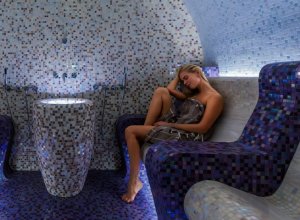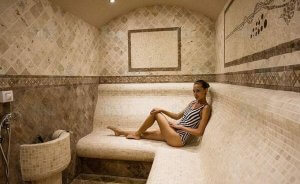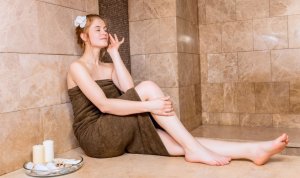Turkish Baths and Their Benefits

Turkish baths, also called hammam (bath, in Arabic), have been popular since ancient times. This bath is famous for having a humidity of 99 percent. It’s a humid heat where the temperature isn’t consistent throughout the room; the higher you go, the hotter it becomes. On the floor, the temperature is maintained between 158 and 194 degrees. At around 1.5 meters high, the temperature will be around 212 degrees, and at head height you can expect temperatures in the region of 248 degrees.
Benefits of the Turkish bath
- Increases oxygen exchange capacity in the lungs and bronchial system.
- The Turkish bath is less stressful for the body than the sauna.
- For people who suffer from stress and anxiety, the Turkish bath relaxes the nervous system.
- Smooths and softens the skin, so it’s very beneficial for people with acne. It also dilates the pores and activates perspiration. This eliminates toxins and impurities from the skin, stimulating blood circulation.
- The Turkish bath moistens the respiratory tract; helping to ease the symptoms of colds, coughs, bronchitis, sinusitis.
- Helps to delay aging of the skin, as it allows a greater oxygenation and revitalization of the tissues.
- It facilitates the secretion of vaginal discharge and helps to clean genitalia. In addition, heat helps to relieve painful menstruation.

Turkish bath precautions
Consider that during a Turkish bath the heart rate doubles due to subjecting the body to such high temperatures. So it’s not recommended for the elderly, pregnant women or for people who suffer health problems, such as high blood pressure or heart disease.
In addition, those suffering from dermatitis or vasodilation problems shouldn’t use the Turkish bath. People suffering from a severe bronchial disease, epilepsy, anorexia or renal colic should also avoid Turkish baths.
How to prepare for a Turkish bath
If we are going to go to the Turkish bath after practicing sports, we should rest for between 15 and 30 minutes after exercise, to allow the body temperature to fall.
Before entering the bathroom, it’s best to shower for a while with warm water. This helps the body become accustomed to the high temperature.
It’s not advisable to enter hungry, but also not with a full stomach. It would be best to eat an hour before entering the Turkish bath.
Don’t forget to stay hydrated, because your body will be subjected to moderate dehydration.

What should you do during the Turkish bath?
When you visit a Turkish bath, it’s best to start in the lower seats. This way, your body adapts to the heat.
During the session don’t drink liquids, otherwise the detoxification process won’t be effective.
Lie down or sit with your feet on the seat so that your whole body remains at the same temperature.
It’s normal that after 8-12 minutes the body needs to recover from the heat, so it is better to leave the bath for a short period, before reentering again.
People who have used Turkish baths before, can stay in there for up to 15 minutes. If it’s your first time, you shouldn’t exceed 10 minutes.
Before exiting the Turkish bath, sit for a while with your feet on the floor, so that your circulation adjusts back to the vertical position, then stand up slowly.
Things you should keep in mind for after the Turkish bath
When leaving the bathroom, it’s advisable to remain outside to cool the respiratory tract, but not in excess; avoid shivering.
Then, shower with cold water, focusing the water jet on the center of the body. Once the Turkish bath has finished you should drink water or an electrolyte drink to recover the mineral salts that have been lost through excessive sweating. It’s not advisable to have more than two weekly Turkish bath sessions.
Turkish baths, also called hammam (bath, in Arabic), have been popular since ancient times. This bath is famous for having a humidity of 99 percent. It’s a humid heat where the temperature isn’t consistent throughout the room; the higher you go, the hotter it becomes. On the floor, the temperature is maintained between 158 and 194 degrees. At around 1.5 meters high, the temperature will be around 212 degrees, and at head height you can expect temperatures in the region of 248 degrees.
Benefits of the Turkish bath
- Increases oxygen exchange capacity in the lungs and bronchial system.
- The Turkish bath is less stressful for the body than the sauna.
- For people who suffer from stress and anxiety, the Turkish bath relaxes the nervous system.
- Smooths and softens the skin, so it’s very beneficial for people with acne. It also dilates the pores and activates perspiration. This eliminates toxins and impurities from the skin, stimulating blood circulation.
- The Turkish bath moistens the respiratory tract; helping to ease the symptoms of colds, coughs, bronchitis, sinusitis.
- Helps to delay aging of the skin, as it allows a greater oxygenation and revitalization of the tissues.
- It facilitates the secretion of vaginal discharge and helps to clean genitalia. In addition, heat helps to relieve painful menstruation.

Turkish bath precautions
Consider that during a Turkish bath the heart rate doubles due to subjecting the body to such high temperatures. So it’s not recommended for the elderly, pregnant women or for people who suffer health problems, such as high blood pressure or heart disease.
In addition, those suffering from dermatitis or vasodilation problems shouldn’t use the Turkish bath. People suffering from a severe bronchial disease, epilepsy, anorexia or renal colic should also avoid Turkish baths.
How to prepare for a Turkish bath
If we are going to go to the Turkish bath after practicing sports, we should rest for between 15 and 30 minutes after exercise, to allow the body temperature to fall.
Before entering the bathroom, it’s best to shower for a while with warm water. This helps the body become accustomed to the high temperature.
It’s not advisable to enter hungry, but also not with a full stomach. It would be best to eat an hour before entering the Turkish bath.
Don’t forget to stay hydrated, because your body will be subjected to moderate dehydration.

What should you do during the Turkish bath?
When you visit a Turkish bath, it’s best to start in the lower seats. This way, your body adapts to the heat.
During the session don’t drink liquids, otherwise the detoxification process won’t be effective.
Lie down or sit with your feet on the seat so that your whole body remains at the same temperature.
It’s normal that after 8-12 minutes the body needs to recover from the heat, so it is better to leave the bath for a short period, before reentering again.
People who have used Turkish baths before, can stay in there for up to 15 minutes. If it’s your first time, you shouldn’t exceed 10 minutes.
Before exiting the Turkish bath, sit for a while with your feet on the floor, so that your circulation adjusts back to the vertical position, then stand up slowly.
Things you should keep in mind for after the Turkish bath
When leaving the bathroom, it’s advisable to remain outside to cool the respiratory tract, but not in excess; avoid shivering.
Then, shower with cold water, focusing the water jet on the center of the body. Once the Turkish bath has finished you should drink water or an electrolyte drink to recover the mineral salts that have been lost through excessive sweating. It’s not advisable to have more than two weekly Turkish bath sessions.
This text is provided for informational purposes only and does not replace consultation with a professional. If in doubt, consult your specialist.








